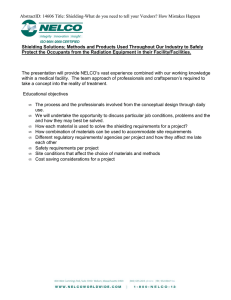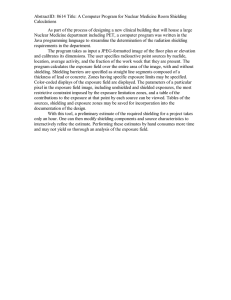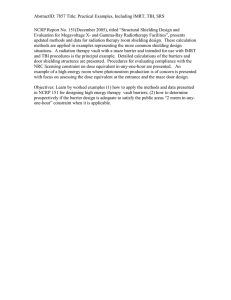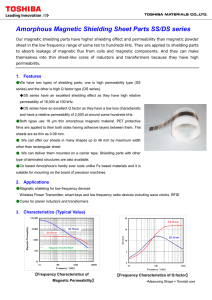Low Frequency Magnetic Shielding – An Integrated Solution
advertisement
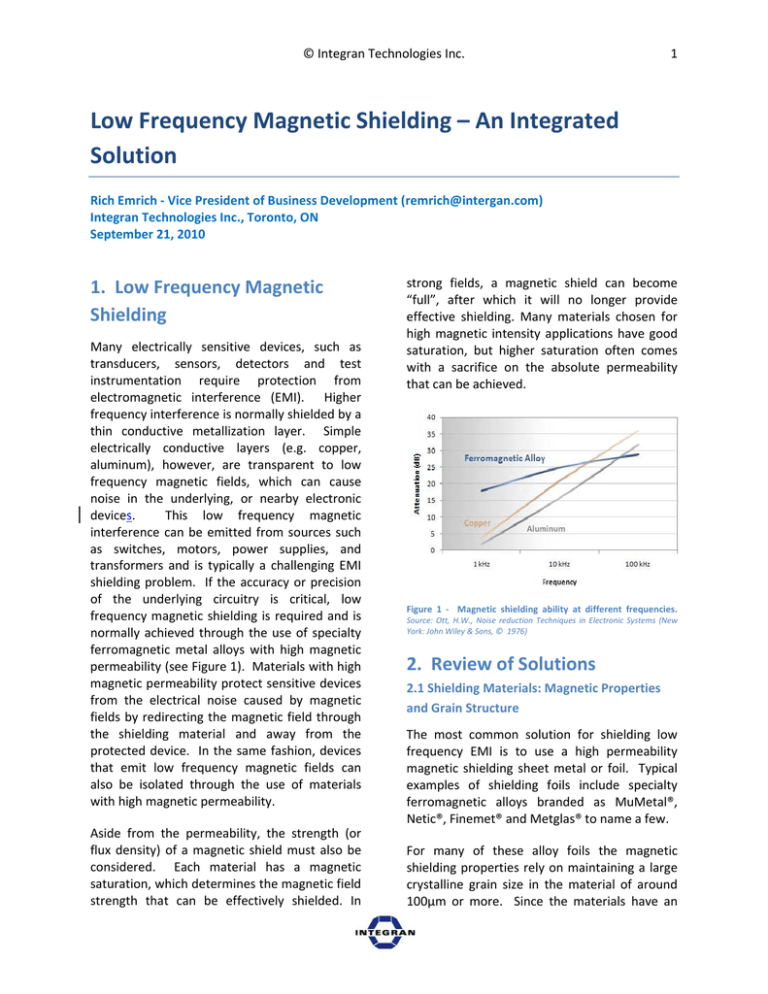
© Integran Technologies Inc. 1 Low Frequency Magnetic Shielding – An Integrated Solution Rich Emrich ‐ Vice President of Business Development (remrich@intergan.com) Integran Technologies Inc., Toronto, ON September 21, 2010 1. Low Frequency Magnetic Shielding Many electrically sensitive devices, such as transducers, sensors, detectors and test instrumentation require protection from electromagnetic interference (EMI). Higher frequency interference is normally shielded by a thin conductive metallization layer. Simple electrically conductive layers (e.g. copper, aluminum), however, are transparent to low frequency magnetic fields, which can cause noise in the underlying, or nearby electronic devices. This low frequency magnetic interference can be emitted from sources such as switches, motors, power supplies, and transformers and is typically a challenging EMI shielding problem. If the accuracy or precision of the underlying circuitry is critical, low frequency magnetic shielding is required and is normally achieved through the use of specialty ferromagnetic metal alloys with high magnetic permeability (see Figure 1). Materials with high magnetic permeability protect sensitive devices from the electrical noise caused by magnetic fields by redirecting the magnetic field through the shielding material and away from the protected device. In the same fashion, devices that emit low frequency magnetic fields can also be isolated through the use of materials with high magnetic permeability. Aside from the permeability, the strength (or flux density) of a magnetic shield must also be considered. Each material has a magnetic saturation, which determines the magnetic field strength that can be effectively shielded. In strong fields, a magnetic shield can become “full”, after which it will no longer provide effective shielding. Many materials chosen for high magnetic intensity applications have good saturation, but higher saturation often comes with a sacrifice on the absolute permeability that can be achieved. Figure 1 ‐ Magnetic shielding ability at different frequencies. Source: Ott, H.W., Noise reduction Techniques in Electronic Systems (New York: John Wiley & Sons, © 1976) 2. Review of Solutions 2.1 Shielding Materials: Magnetic Properties and Grain Structure The most common solution for shielding low frequency EMI is to use a high permeability magnetic shielding sheet metal or foil. Typical examples of shielding foils include specialty ferromagnetic alloys branded as MuMetal®, Netic®, Finemet® and Metglas® to name a few. For many of these alloy foils the magnetic shielding properties rely on maintaining a large crystalline grain size in the material of around 100µm or more. Since the materials have an © Integran Technologies Inc. 2 equilibrium state grain size of around 1‐10µm, the large grain structure must be achieved through annealing the metal at high temperatures, often in a tightly controlled atmosphere to control impurities. Other foils have an amorphous (i.e. no crystalline grains) or nanocrystalline structure which is normally achieved through complex manufacturing techniques including rapid solidification and high frequency annealing processes. 2.2 Existing Shielding Solutions Although specialty foils are very effective EMI shields, they are best suited to shielding simply shaped parts. There are currently a few methods for creating parts with relatively complex geometries, described in Figure 2 and Figure 3. Figure 2 ‐ Existing Shielding Solutions (Part 1). Figure 3 ‐ Existing Shielding Solutions (Part 2). 2.3 Foil Lay‐up and Formed Foils Since sheet metal or foils are manufactured flat, materials that resist forming operations, like glassy amorphous alloys, must be cut to shape and laid onto flat surfaces in order to achieve the necessary part shielding. Although these materials have excellent shielding performance, this lay‐up approach is a cumbersome method for shielding parts with any contour or shape. Other less brittle shielding materials can also be cut and formed to the shape required. For example, a sensitive transducer measuring a faint analog current might require a “can” of material to be formed to integrate into the enclosure or circuit board for the device. This shape would need to be cut and stamped from the original sheet metal or foil supply. Although this process adds cost to the shield, it is not, in itself, a particularly challenging operation. Unfortunately, the forming operation reduces the effectiveness of the shield by introducing deformation into the material – destroying the key material characteristic that generates the high permeability. To restore the defect‐free structure, the material must be annealed once more in the high temperature controlled environment to restore shielding effectiveness. © Integran Technologies Inc. This presents a restriction for customers as the forming operation now has to be coupled with an annealing operation, limiting the possible manufacturers, or adding an additional step in the supply chain. Moving away from shielding efficacy, the forming step also sets a practical size limit as complex or small geometries are difficult to produce. As electronic structures and packaging shrinks, discrete, formed shields may not be the optimal solution. Lastly, once the discrete shield is cut, formed, and annealed, it still needs to be integrated into the assembly of the shielded part. This integration requires labor and often relies on adhesives, further adding to the assembly part count, and complicating the assembly cost and complexity. 2.4 Metal Injection Molding Fine specialty ferromagnetic powders can now be injection molded with a binder to create complex parts that are effective low frequency magnetic shields. After molding, the parts are thermally or chemically treated and then sintered at high temperatures where the binder is removed. Secondary operations are sometimes required to achieve the final shape. Although this process can make effective shields in relatively complex forms, part shrinkage must be accounted for, as well as mechanical considerations such as part porosity (2%) and brittleness. As tooling costs can be high, this method is ultimately best suited for high volume but relatively small parts. 3 applications where weight is critical, steel is often being replaced by other materials such as polymers or aluminum which have little or no low frequency shielding capability. These materials must often be combined with one of the other aforementioned solutions or the direct part coating solution discussed in the next section. 3. Alternative solution: direct Coating of parts with Nanovate™ EM An alternative solution is to apply a high magnetic permeability Nanovate™ EM coating directly to the surface of a part, as shown in Figure 4. This process is more easily adapted to small and complex shield shapes and avoids many of the possible drawbacks of a discrete shield, including eliminating annealing steps. 2.5 Metal Components Finally, conventional metal components can also be used for low‐frequency EMI shielding such as steel stampings. For many applications, this can be a very cost effective method but the weight addition can be problematic in some applications. Much thicker steel stock will be required to achieve the same shielding effectiveness as specialty ferromagnetic alloys and in many cases a minimum thickness of steel is required for the forming operations. In many Figure 4 ‐ Part coated with a Nanovate™ EM coating. Coating parts with conductive surfaces has often been used for high frequency EMI shielding in electronics applications using techniques such as PVD, conductive paints, and electroless and electrolytic plating. In these © Integran Technologies Inc. cases, the primary requirement is a thin conductive coating. With the recent introduction of high magnetic permeability Nanovate™ coatings, the same concept can now be used for low frequency magnetic shielding. 4 benefit lies in their processing and design flexibility. These materials are used most frequently as a coating directly onto part substrates such as metals (e.g. aluminum enclosures), polymers (e.g. thermoplastic formed parts) and composites (e.g. carbon fiber composite structures), which avoids any forming operations. The coating can be integrated directly into the part packaging or enclosure, which reduces part count by eliminating the discrete formed shield and related adhesives and labor. Selective coating is possible, allowing shielding performance that can be delivered where it is needed most and avoiding unnecessary added weight. For injection molded polymers in particular, monolithic part integration is now possible where the shielding function can be molded directly into the larger electronics enclosure or part packaging. 3.1 Magnetic Properties OF Nanovate™ EM Coatings In contrast to conventional shielding materials which derive magnetic properties from their large, un‐deformed grain structure, Nanovate™ EM coatings derive their magnetic properties from their very small (nanometer, in fact) grain structure. Similar to large grained shielding materials, Nanovate™ EM coatings can achieve high permeability, and therefore similar magnetic shielding performance. The graph shown in Error! Reference source not found. illustrates the relationship between coercivity and grain size for ferromagnetic materials. The graph shows that coercivity is at a minimum when grain size is reduced to the nanometer scale or increased to the micron scale. Typically, magnetic shielding materials with low coercivity also possess high permeability, and, in turn, exhibit good low frequency magnetic shielding characteristics. Figure 5 ‐ Trend of coercivity vs. grain size. Source: Adapted from G. Herzer, Mat. Sci. Eng., A133 (1991). 3.2 Processing and Design Benefits and limitations of Nanovate™ EM While the magnetic shielding characteristics of Nanovate™ EM coatings are good, their real Figure 6 ‐ Aluminum housing coated with nanocrystalline ferromagnetic coating. Source: Integran Technologies Inc. Aside from avoiding the forming operation, deformation Nanovate™ EM coatings does not affect their grain size and therefore retains the shielding effectiveness, avoiding both a loss in performance and a re‐annealing step. On the other hand, the long term operating temperature must be kept under a threshold of © Integran Technologies Inc. approximately 400°F (varies, depending on alloy composition) to avoid grain growth back to a larger crystalline equilibrium state. As with any solution this approach has its own drawbacks. The metal coating operation is a secondary operation which adds cost to the part. In addition, the thickness and distribution of metal in a typical deposition process for nanocrystalline metals is influenced by part geometry. Despite these factors, the application process is industrially scalable, and the metal coating approach is effective where discrete shields are awkward or impractical. 5 The part also benefitted from increased surface hardness, and an aesthetically pleasing finish. Polymer parts can also benefit greatly from direct coating with Nanovate™ EM. Complex moldings can be coated to provide additional stiffness, strength and surface hardness in addition to magnetic shielding, thereby to creating multifunctional parts. These metal/polymer hybrid parts can be lighter and thinner than their fully metal die‐cast counterparts. Error! Reference source not found.Figure 7 depicts a cell phone housing coated with Nanovate™ EM, adding stiffness and strength to the polymer part. Figure 8 shows a similar polymer housing with the coating applied selectively. This delivers shielding performance where it’s required, eliminating unnecessary weight. Using a selective coating process can enable monolithic integration of discrete parts in an assembly, reducing part cost. Figure 7 ‐ Polymeric cell phone components coated with nanocrystalline Nanovate™ shielding. Source: Integran Technologies Inc. An example of a metal part which can benefit from direct part coating is shown in Figure 6 which depicts a complex aluminum machined housing that required shielding. The application is weight sensitive and required layups of mu‐ metal foils in most areas and labor intensive work to bend the foils and bond them to shield the corners. As an alternative, 50 microns thick Nanovate™ EM coating was applied by Integran Technologies. The part has performed well in initial EMI testing and the majority of the foils could be eliminated, saving weight and cost. Figure 8 ‐ Polymeric cell phone component selectively coated with nanocrystalline Nanovate™ shielding. Source: Integran Technologies Inc. 3.3 Material Property Benefits of Nanovate™ EM Another useful property of nanocrystalline Nanovate™ EM coatings is that they have a higher strength and hardness than their coarse‐ grained counterpart materials. When applied to polymer substrates, this higher strength can be used to dramatically increase the strength and stiffness of the hybrid part. A relatively © Integran Technologies Inc. weak or flexible polymer enclosure can now become a rigid structural part with good durability. The high yield strength and good ductility also make the coating particularly well suited for polymer and composite applications which experience a lot of flexing. In bending or flexing applications, lower strength coatings would plastically deform, and traditional high strength coatings, which are normally brittle, would crack and fail at low loads. Examples of the improvement in mechanical properties of Nanovate™ EM with respect to conventional magnetic shielding foils are shown in Figure 9 and Figure 10. 6 4. Summary Figure 9 ‐ Improved Yield Strength. Source: Integran Technologies Inc. In summary, while specialty ferromagnetic foils and sheet metal stock are useful for creating relatively simple geometry discrete magnetic shields, they require forming, annealing, and assembly steps and are not amenable to small or complex parts. Metal injection molding and standard steel parts can also solve many shielding problems but run into challenges in weight and lower shielding effectiveness. Nanocrystalline ferro‐magnetic metal coatings, such as Nanovate™ EM offer an alternative solution for directly shielding metal, polymer, or composite parts which can reduce cost by simplifying the supply chain and assembly process. This metal coating process also opens the door to small or complex shields which were previously impractical with discrete shields. Additional benefits can also be realized by using the superior mechanical properties of nanocrystalline metals to strengthen, stiffen, render impermeable, or add durability to a polymeric part. A summary of characteristics of Nanovate™ EM, and conventional shielding foil is shown in Figure 11. Nanocrystalline metals can now be made fully dense, meaning they have no voids or porosity. Having a highly impermeable coating could be beneficial either for keeping liquids or gases from penetrating the surface of a part, as would be the case for protecting a polymer case from chemical attack, or from keeping the part from outgassing into the environment. This may be a secondary consideration in semiconductor or space applications. Figure 11 ‐ Summary of Characteristics of Nanovate™ EM, and Conventional Shielding Foil. About Integran Technologies Inc. Figure 10 ‐ Improved Hardness. Source: Integran Technologies Inc. Integran Technologies Inc. is a world leader in the development and commercialization of advanced nanocrystalline metal coatings and © Integran Technologies Inc. other metallurgical nano‐technologies. Integran’s affiliated companies include: Powermetal Technologies (Carlsbad, CA) which develops and manufactures products for the sports equipment and consumer product sectors; and Integran Technologies USA (Pittsburgh, PA) which is focused on commercialization of Integran’s technologies in the United States. Web www.integran.com 7
